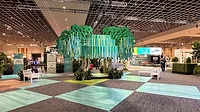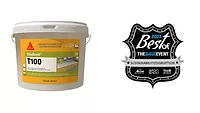Sustainability, Innovation Lead Opportunities in Hardwood Flooring for 2023

Noble Hall by Anderson Tuftex features 7-inch wide planks in white oak and wire-brushed surface.
Photo: Anderson Tuftex.
While the flooring market is experiencing a number of challenges in 2023—economic and political uncertainty, housing market fluctuations, labor shortages, competitive pressures and supply chain disruptions—the wood category is still looking optimistic.
“It’s interesting to compare and contrast the national conversation and our niche industry’s conversation about the economy,” said Michael Martin, president and CEO, National Wood Flooring Association (NWFA). “In general, there’s a bit of darkness about homebuilding and interest rates, yet our members continue to look for new employees and have work lined up a couple of months out. While it’s not the rush of work that came with COVID, business is steady for most.”
Wood continues to gain steam thanks to consumers’ continued focus towards sustainable products to promote a healthier environment. Consumer awareness about environmental conservation has led to high demand for eco-friendly flooring products such as bamboo, glass, rubber, cork, linoleum, and hardwood.
Environmental Product Declarations (EPD) have become a way to verify a product’s environmental impacts. EPDs offer objective, scientific data that quantifies how a product is made, and how that product impacts the environment during its entire life cycle.
NWFA and the Decorative Hardwoods Association (DHA) recently announced the completion of two new EPDs which show the sustainability of wood flooring over other categories. Two EPDs (https://nwfa.org/environment/) have been published, one for solid wood floors and another for engineered wood floors.
"For years, flooring manufacturers across all categories have marketed their products as environmentally friendly, but concrete data to support these claims has been scarce, until now," Martin said. “Both show, conclusively and with third-party scientific data, that wood flooring has significantly fewer environmental impacts than any other flooring product.”
Developed by the Athena Sustainable Materials Institute, the results of the joint NWFA/DHA EPDs reveal that both solid and engineered wood flooring possess a considerably smaller carbon footprint, or Global Warming Potential (GWP), compared to all other flooring product categories that have published EPDs. This finding carries significant weight as carbon efficiency and transparency increasingly influence capital investments and procurement decisions.
EPDs commonly are utilized by builders, architects, and specifiers to meet requirements for green building rating systems such as LEED v4.1. They also establish an industry benchmark against which product-specific EPDs can be measured. This is because products intended for the same use adhere to the same Product Category Rules (PCRs), ensuring that comparisons of similar products are based on identical scientific criteria.
“With this new conclusive evidence, combined with the common sense that we can naturally grow more wood flooring in a responsible way, there’s no argument left to have over which flooring is most sustainable,” Martin said.
In addition to the new EPDs, NWFA recently launched its Engineered Wood Flooring Refinishable Program, a voluntary certification program that designates whether a manufacturer’s wear layer is capable of being refinished.
“The launch of this program comes at a time when both the industry and the consumer are fraught with confusion with lookalike products and thin wear layers,” Martin said. “This designation quickly allows the consumer and the salesperson to identify a flooring option that can be resanded and refinished when either wear happens, or new colors come in fashion.”
Later this summer, on the technical front, NWFA will release a revised version of the NWFA Species Guide which expands the number of species covered, as well as packaging guides, new illustrations and photos.
| Country | 2020 | 2021 | 2022 | 2022 | 2023 | YTD % Change |
|---|---|---|---|---|---|---|
| Vietnam | 117,132,376 | 164,014,924 | 209,069,111 | 30,875,205 | 30,704,455 | -0.60% |
| Cambodia | 111,210,306 | 161,467,918 | 154,768,975 | 32,010,627 | 18,582,552 | -41.90% |
| China | 172,478,987 | 173,017,541 | 137,787,932 | 26,928,406 | 15,526,386 | -42.30% |
| Malaysia | 28,512,988 | 31,420,378 | 42,242,152 | 8,348,958 | 5,055,142 | -39.50% |
| Thailand | 13,977,239 | 32,326,259 | 47,188,012 | 9,139,821 | 5,176,377 | -43.40% |
| Indonesia | 19,330,189 | 28,531,576 | 37,518,448 | 7,218,091 | 4,045,127 | -44.00% |
| Canada | 17,680,692 | 23,375,268 | 25,815,602 | 3,159,615 | 3,059,369 | -3.20% |
| Brazil | 7,419,439 | 8,820,366 | 16,827,471 | 3,072,322 | 2,428,545 | -21.00% |
| Italy | 3,725,276 | 1,982,590 | 13,080,837 | 431,455 | 1,448,335 | 235.70% |
| Taiwan | 7,063,039 | 9,800,916 | 8,933,960 | 1,523,044 | 2,433,303 | 59.80% |
| Subtotal | 498,530,533 | 634,757,736 | 693,232,501 | 122,707,544 | 88,459,590 | -27.90% |
| All Others | 61,345,712 | 74,846,384 | 68,181,093 | 9,082,826 | 7,664,574 | -15.60% |
| Total Imports | 559,876,244 | 709,604,120 | 761,413,594 | 131,790,370 | 96,124,164 | -27.10% |
Wood Market Update
The North America wood flooring market size was estimated at $7.4 billion in 2022 and is expected to expand at a compound annual growth rate (CAGR) of 2.4% from 2023 to 2030, according to Grand View Research headquartered in San Francisco.
The category continues to accelerate innovation and design in an effort to capture back market share from competing flooring categories.
The residential application segment dominated in 2022 with a 77.9% share of total revenue. The rising number of single-family houses in the U.S. post the great recession of 2008-2009 has played an important role in increasing the usage of wooden floor covering materials in the residential segment.
Continued investment in the renovations and remodels of existing homes was the primary factor driving the segment growth. Wood floors have aspirational design value, and as a result, more people are replacing their existing flooring with wood floors. Significant and continual growth of high-end residential housing in North America and the subsequent and growing preference for single-family housing are further driving the demand for wood flooring. Furthermore, with the ever-increasing growth of interior design and real estate sectors, floor-covering solutions, accessories, and equipment have gained considerable importance.
Global Warming Potential (GWP)
Comparison of North American Made Flooring Products
Source: NWFA
GWP impact data was taken from industry averged EPDs in all flooring categories except carpet tile and boradloom carpet, which are not available. Carpet impact data was collected from a search of publicaly available product specific EPDs. GWP impact data is presented in kg of CO2 equivalent gases per square meter of flooring.
New construction accounted for a volume of 95.4 million square meters in 2022. The segment is further expected to grow at a significant CAGR through 2030. Increasing new residential as well as commercial construction in North America is fueling the new construction sector, which in turn is expected to propel the demand for wooden flooring products during the forecast period.
Installation Innovations
Installation of flooring is a difficult and time-consuming task, but now companies have come up with products don’t require adhesives and save time and will reduce the cost of installations.
Engineered Wood
Engineered wood flooring was the largest product segment, accounting for 66.6% of revenue share in 2022. The engineered wood flooring product segment accounted for the largest share of the North America market in 2022. Engineered wood flooring is increasingly replacing traditional solid wood flooring in the residential sector owing to its cost-effectiveness, ease of installation, and superior moisture resistance properties.
The U.S. International Trade Commission reported that after increasing by 11% in 2022, U.S. imports of engineered wood flooring through February are down by more than 27% in volume versus the same period last year. The value of imports from nearly all countries declined, with one notable exception: the volume of imports from Vietnam remained the same. While tariffs helped cut U.S. imports of Russian plywood in half, the U.S. still directly imported at least $1.2 billion worth from Russia in 2022. Plywood remains one of the largest sectors of goods shipped directly from Russia and Belarus into the U.S. and accounts for about half of all Russian consumer goods imported into the U.S. from November to January.
Solid Wood
Solid wood is expected to grow at the highest CAGR of 2.9% through 2030, according to Grand View Research. The product offers an option to choose from a wide variety of dent and scratch-resistant wood species, which is expected to increase the demand for solid wood floors in North America. In addition, it has a superior ability to protect against stains along with a well-polished nature. Solid wood floors can be sanded and re-finished multiple times over their lifetime on account of their top-to-bottom solid core.
Wood Types
In 2022, the red oak segment emerged as the largest wood type segment while accounting for 35.2% revenue share of the North America wood flooring market. Factors such as abundant domestic availability of the red oak timber coupled with its affordable cost, and moderate to heavy graining were responsible for the segment growth and are further expected to increase the demand for the product in North America.
Red oak is widely used in the wooden flooring industry owing to its relatively lower cost. Further characteristics, which are increasing the demand for red oak for the production of wooden floors include a straight graining pattern, coarse texture, and superior durability with a Janka value of 1290. The red oak wood is relatively easy to work with and can be easily machined and nailed to the subfloor.
White oak accounted for revenue of $2.2 billion in 2022 and is expected to grow at a significant CAGR through 2030. White oak or Quercus alba is one of the most commonly used hardwood timber species native to the Eastern and Central North America region. White oak hardwood flooring is more water resistant as compared to the other types of floors, making it a good option for use in kitchens along with entryways, dining rooms, and bedrooms. Furthermore, these types of flooring are available in a smooth and homogenous texture, which is expected to pave the way for use in the North America flooring industry during the forecast period.
Looking for a reprint of this article?
From high-res PDFs to custom plaques, order your copy today!





